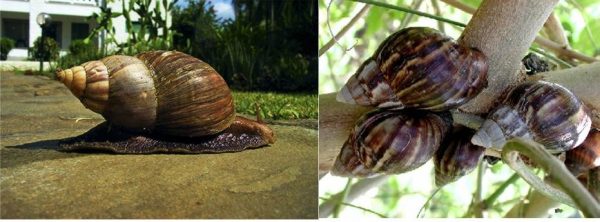SHIPPERS GUIDE
How To Maximize Snail Farming For Export
Snail farming in Nigeria is considered to be one of the most lucrative agribusiness you can start with low capital. Yet, it is one of the most neglected animal rearing business in these countries. Snail farming provides one of the finest opportunity to make money within a short period of time. But why are Africans not yet fully engaged in this money making animal rearing? The reason is ignorance.
In Australia and USA, snail farming is big business, providing opportunities to many farmers. In Uk, snails can be seen in many supermarkets and stores. meaning it is a big deal there. Most people in Nigeria and Ghana still have the believe that snail can only be picked in the bush. The culture of going to the bush to pick snails in the villages during raining time has been there for generations. So, it is difficult for people to come to term that snail can actually be kept and grown at home.
Just like many other aspects of farming in these countries, Africans are yet to discover the great money making potential in this business and that is why we suffer in hunger and poverty. We neglect where the money is and keep pursuing it where it is not, going from one city to the other looking for one petty China made goods after another to trade on. Laboring away in Europe and America in search of greener pastures when our own continent is already green.
How Profitable is Snail Farming?
Land snails belongs to the class of Molluscan, Gastropod. The one popularly known as ‘Congo Meat‘ in many parts of Africa. Nigeria – Eju, Igbin, etc… There are so many species of snails but the types we are looking at here are the ones that are suitable for commercial Snail Farming in Africa.
After reading this article, you will be on your way to starting your own snail farming business in easy and simple steps. And we are backing it up with a Practical Snail eBook for those who can afford it.
Making ₦5,000,000 annually in snail rearing is a done deal if you do it well and get get the whole process right.
Which Snail Species Are Suitable for Snail Farming?
Achatina Fulica – The East African Snail
The East African land snail, or giant African land snail, scientific name Achatina fulica, is a species of large, air-breathing land snail, a terrestrial pulmonate gastropod mollusk in the family Achatinidae. It is the smallest in size among all the desirable species for rearing in Africa.
Achatina fulica has a narrow, conical shell, which is twice as long as it is wide and contains 7 to 9 whorls when fully grown. The shell is generally reddish-brown in colour with weak yellowish vertical markings but colouration varies with environmental conditions and diet. A light coffee colour is common. Adults of the species may exceed 20cm in shell length but generally average about 5 to 10cm. The average weight of the snail is approximately 32 grams.
Achatina Achatina
Achatina achatina, common name the giant Ghana snail, also known as the giant tiger land snail, is a species of very large, air-breathing land snail, a terrestrial pulmonate gastropod mollusk in the family Achatinidae. Giant African land snails are hemraphrodites, meaining they possess both the female and male reproductive organs. Two snails are still needed for breeding, but they are very prolific breeders.
Similar to the other species in the genus, Achatina achatina’s shell can attain a length of 200 mm and a maximum diameter of 100 mm. They may possess between 7-8 whorls and the shell is often broadly ovate. The body of the animal is silver-brown in color although albino morphs may exist.
Achatina-Achatina is very good for commercialization as well, because of its profitability. This is because of the volume of eggs it lays at once. Each achatina lays 300 to 500 eggs at a time in clutches, three times a year. Therefore, if you start a farm with about 1000 snails, in one year you would be getting about 1.5 million snails going by the number of eggs they produces.
Archachatina Marginata
Archachatina marginata, common name the giant West African snail, is a species of air-breathing tropical land snail, a terrestrial pulmonate gastropod mollusk in the family Achatinidae. They can grow up to 20cm long, and live up to 10 years.
Among these three species, Achatina Achatina is the most desirable for farmers because it grows so big to become the biggest snail species in the world. Achatina Achaina has it’s origin from Nigeria, get to Liberia from Nigeria and then Ghana.
Another reason is due to it’s high yield capacity. The other species are very good too but I will focus on Achatina Achatina and Archachatina Marginata in this blog post because, they are easy to find in Nigeria.
Having decided on the specie, let’s take you through the step by step how to setup your snail farm in a small scale level and starts rearing your snail towards harvest.
Suitable Environment for Snail Farming
Snails are easily dehydrated, and wind increase the rate of moisture loose in snail which in turn, leads to the dryness of the animal. To prevent snails from losing water so quickly, your snaileries (the snail house) must be located in environment that is protected from wind.
A low plain, downhill site surrounded with enough trees is perfect for snail farming. You may plant plantains and bananas around your snail farm to prevent the impact of wind.
Type of Soil For Snail Farming
Snail’s major habitat is the soil, and soil contains some of the components and chemical substances that it needed to survive. However, not all soils are suitable for snail rearing. The shell of the snail is mainly calcium and it derive most of them from the soil. Snail also lay it’s eggs on the soil and drink water out of the soil.
Hence, the suitable soil for snail farming must contain these elements. Must be balanced, not waterlogged, not too dry, and must not be acidic. The most desirable soil for snail is sandy-loamy soil with low water holding capacity. Clayey soil and acidic soil must be avoided.
Getting The Sails For Farming
To start up a snail farm, it is advisable to get snails directly from the forest instead of buying from the market after they have been exposed to sunlight and have dehydrated. This is because snails drink a lot of water, so are easily dehydrated and this stresses them out, and reduce their fertility capacity.
The intending snail farmer could pick the snails from the bush with a very simple technique; clear a little portion of land during rainy season and sprinkle spicy fruits like pineapple, pawpaw, plantain, banana etc at about 5o’clock in the evening, when you go back there about 7pm or 8pm, you will pick up snails suitable for rearing. Repeat the procedure until you get enough quantity.
Another way could be to pick up snail eggs littered in the market place where it is sold and through a technique, check the fertility of the eggs, because some of them must have lost fertility due to the exposure to sunlight. The eggs are later put inside a container containing wet sand and covered with cocoyam leaf. Between 21 to 28 days, the eggs would hatch into baby snails. You start feeding them and gradually you raise a snail farm.”
Constructing the Snail House (Snailery)
Snaileries can vary from a patch of fence-protected ground, sheltered from the wind to a covered box if you are breeding in small scale.
For larger population of snails, you can dug a trench or make a concrete pen with soil deep of about 10 inches, and cover it with screen or wire all around to prevent the snails from escaping. Remember that snails can reproduce fast and become pests when their breeding is uncontrolled.
Snails love dark and cold places, but make sure the humidity does not drop to levels harmful to the snails. You can use fresh leaves and cloth that is regularly wet to regulate the temperature.
Also, the wire is useful in keeping away rats and snakes or other predators from eating the snails in your snail farm. But aside from these bigger predators, you should be wary about smaller ones like ants and termites. Your construction must have these predators in mind.
Snail Food and Feeding
Snails especially Achatina mainly feeds on green leaves and fruits though they can utilize other ranges of foods. Feed your snails leaves, fruits, or even formula from the feed store. Aside from food to grow tissues, snails need calcium to grow shells.
Leaves: Cocoyam leaves, pawpaw leaves, okra leaves, cassava leaves, eggplant leaves, cabbage and lettuce leaves.
Fruits: Mango, eggplant, pawpaw, banana, tomatoes, oil palm fruits, pears. and cucumber.
Once they start growing, separate the big ones from the small ones. It take more than a year for the Achatina type to grow to harvest size. Others mature in two years.
Once they start growing, separate the big ones from the small ones. It take more than a year for the Achatina type to grow to harvest size. Others mature in two years.
One hundred thousand snails after a year or two sold at the rate of N50 each (highly reduced price) will give you about N5 million! Isn’t that a good investment?
Harvesting the Snail
It is not economically wise to harvest your snails before it’s maturity, it has to be matured before harvesting. To know if your snails are already matured enough, check the brim of the shell. If it is matured enough, the brim should be thicker and harder than other parts of the shell.
Do not harvest all the matured snails at once for the market. It is important to keep few for breeding and to serve as base stock for your snail farm.






